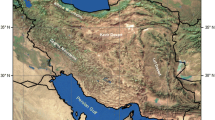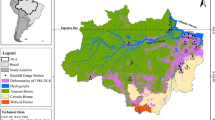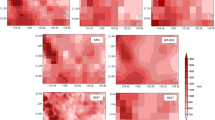Abstract
This study presents a new dynamical downscaling strategy for extreme events. It is based on a combination of statistical downscaling of coarsely resolved global model simulations and dynamical downscaling of specific extreme events constrained by the statistical downscaling part. The method is applied to precipitation extremes over the upper Aare catchment, an area in Switzerland which is characterized by complex terrain. The statistical downscaling part consists of an Artificial Neural Network (ANN) framework trained in a reference period. Thereby, dynamically downscaled precipitation over the target area serve as predictands and large-scale variables, received from the global model simulation, as predictors. Applying the ANN to long term global simulations produces a precipitation series that acts as a surrogate of the dynamically downscaled precipitation for a longer climate period, and therefore are used in the selection of events. These events are then dynamically downscaled with a regional climate model to 2 km. The results show that this strategy is suitable to constraint extreme precipitation events, although some limitations remain, e.g., the method has lower efficiency in identifying extreme events in summer and the sensitivity of extreme events to climate change is underestimated.








Similar content being viewed by others
References
Ban N, Schmidli J, Schär C (2014) Evaluation of the convection-resolving regional climate modeling approach in decade-long simulations. J Geophys Res Atmos 119(13):7889–7907. https://doi.org/10.1002/2014JD021478
Bowden JH, Talgo KD, Spero TL, Nolte CG (2016) Assessing the added value of dynamical downscaling using the standardized precipitation index 2016:1–14. https://doi.org/10.1155/2016/8432064. http://www.hindawi.com/journals/amete/2016/8432064/
Chan SC, Kendon EJ, Roberts N, Blenkinsop S, Fowler HJ (2017) Large-scale predictors for extreme hourly precipitation events in convection-permitting climate simulations. J Clim 31(6):2115–2131. https://doi.org/10.1175/JCLI-D-17-0404.1
Dawson CW, Wilby R (1998) An artificial neural network approach to rainfall-runoff modelling. Hydrol Sci J 43(1):47–66. https://doi.org/10.1080/02626669809492102
Doswell CA, Brooks HE, Maddox RA (1996) Flash flood forecasting: an ingredients-based methodology. Weather Forecast 11(4):560–581. https://doi.org/10.1175/1520-0434(1996)011<0560:Fffaib>2.0.Co;2
Eyring V, Bony S, Meehl GA, Senior CA, Stevens B, Stouffer RJ, Taylor KE (2016) Overview of the coupled model intercomparison project phase 6 (CMIP6) experimental design and organization. Geosci Model Dev 9(5):1937–1958. https://doi.org/10.5194/gmd-9-1937-2016
Fantini A, Raffaele F, Torma C, Bacer S, Coppola E, Giorgi F, Ahrens B, Dubois C, Sanchez E, Verdecchia M (2016) Assessment of multiple daily precipitation statistics in ERA-interim driven med-CORDEX and EURO-CORDEX experiments against high resolution observations. Clim Dyn. https://doi.org/10.1007/s00382-016-3453-4
Felder G, Gómez-Navarro JJ, Zischg AP, Raible CC, Röthlisberger V, Bozhinova D, Martius O, Weingartner R (2018) From global circulation to local flood loss: coupling models across the scales. Sci Total Environ 635:1225–1239. https://doi.org/10.1016/j.scitotenv.2018.04.170
Ferro CAT, Stephenson DB (2011) Extremal dependence indices: improved verification measures for deterministic forecasts of rare binary events. Weather Forecast 26(5):699–713. https://doi.org/10.1175/WAF-D-10-05030.1
Froidevaux P, Martius O (2016) Exceptional integrated vapour transport toward orography: an important precursor to severe floods in Switzerland. Q J R Meteorol Soc 142(698):1997–2012. https://doi.org/10.1002/qj.2793
García-Valdecasas Ojeda M, Gámiz-Fortis SR, Castro-Díez Y, Esteban-Parra MJ (2017) Evaluation of WRF capability to detect dry and wet periods in Spain using drought indices: WRF capability to detect drought. J Geophys Res Atmos 122(3):1569–1594. https://doi.org/10.1002/2016JD025683
Gent PR, Danabasoglu G, Donner LJ, Holland MM, Hunke EC, Jayne SR, Lawrence DM, Neale RB, Rasch PJ, Vertenstein M, Worley PH, Yang ZL, Zhang M (2011) The community climate system model version 4. J Clim 24:4973–4991. https://doi.org/10.1175/2011JCLI4083.1
Giannakaki P, Martius O (2016) Synoptic-scale flow structures associated with extreme precipitation events in northern Switzerland. Int J Climatol 36(6):2497–2515. https://doi.org/10.1002/joc.4508. https://rmets.onlinelibrary.wiley.com/doi/abs/10.1002/joc.4508
Gilleland E, Katz RW (2016) extRemes 2.0: an extreme value analysis package in r 72(8). https://doi.org/10.18637/jss.v072.i08. http://www.jstatsoft.org/v72/i08/
Giorgi F, Torma C, Coppola E, Ban N, Schär C, Somot S (2016) Enhanced summer convective rainfall at alpine high elevations in response to climate warming. Nat Geosci 9(8):584–589. https://doi.org/10.1038/ngeo2761
Gómez-Navarro JJ, Raible CC, Bozhinova D, Martius O, García Valero JA, Montávez JP (2018) A new region-aware bias-correction method for simulated precipitation in areas of complex orography. Geosci Model Dev 11(6):2231–2247. https://doi.org/10.5194/gmd-11-2231-2018
Hewitson BC, Daron J, Crane RG, Zermoglio MF, Jack C (2014) Interrogating empirical–statistical downscaling. Clim Change 122(4):539–554. https://doi.org/10.1007/s10584-013-1021-z
Hurrell JW, Holland MM, Gent PR, Ghan S, Kay JE, Kushner PJ, Lamarque JF, Large WG, Lawrence D, Lindsay K, Lipscomb WH, Long MC, Mahowald N, Marsh DR, Neale RB, Rasch P, Vavrus S, Vertenstein M, Bader D, Collins WD, Hack JJ, Kiehl J, Marshall S (2013) The community earth system model: a framework for collaborative research. Bull Am Meteorol Soc 94:1339–1360. https://doi.org/10.1175/BAMS-D-12-00121.1
Lee S, Cho S, Wong PM (1998) Rainfal prediction using artificial neural networks. J Geogr Inf Decis Anal 2(2):233–242
Lehner F, Joos F, Raible CC, Mignot J, Born A, Keller KM, Stocker TF (2015) Climate and carbon cycle dynamics in a CESM simulation from 850 to 2100 CE. Earth Syst Dyn 6(2):411–434. https://doi.org/10.5194/esd-6-411-2015
Li G, Zhang X, Zwiers F, Wen QH (2011) Quantification of uncertainty in high-resolution temperature scenarios for North America. J Clim 25(9):3373–3389. https://doi.org/10.1175/JCLI-D-11-00217.1
Maraun D, Wetterhall F, Ireson AM, Chandler RE, Kendon EJ, Widmann M, Brienen S, Rust HW, Sauter T, Themeßl M, Venema VKC, Chun KP, Goodess CM, Jones RG, Onof C, Vrac M, Thiele-Eich I (2010) Precipitation downscaling under climate change: recent developments to bridge the gap between dynamical models and the end user. Rev Geophys 48:3. https://doi.org/10.1029/2009RG000314
Maraun D, Widmann M, Gutiérrez JM, Kotlarski S, Chandler RE, Hertig E, Wibig J, Huth R, Wilcke RA (2015) VALUE: a framework to validate downscaling approaches for climate change studies. Earth’s Future 3(1):1–14. https://doi.org/10.1002/2014EF000259
Martinez Y, Yu W, Lin H (2012) A new statistical–dynamical downscaling procedure based on EOF analysis for regional time series generation. J Appl Meteorol Climatol 52(4):935–952. https://doi.org/10.1175/JAMC-D-11-065.1
Martius O, Zenklusen E, Schwierz C, Davies HC (2006) Episodes of alpine heavy precipitation with an overlying elongated stratospheric intrusion: a climatology. Int J Climatol 26:1149–1164
Meredith EP, Rust HW, Ulbrich U (2018) A classification algorithm for selective dynamical downscaling of precipitation extremes. Hydro Earth Syst Sci 22(8):4183–4200. https://doi.org/10.5194/hess-22-4183-2018
Messmer M, Gómez-Navarro JJ, Raible CC (2015) Climatology of vb cyclones, physical mechanisms and their impact on extreme precipitation over central europe. Earth Syst Dyn 6(2):541–553. https://doi.org/10.5194/esd-6-541-2015
Messmer M, Gómez-Navarro JJ, Raible CC (2017) Sensitivity experiments on the response of vb cyclones to sea surface temperature and soil moisture changes. Earth Syst Dyn 8(3):477–493. https://doi.org/10.5194/esd-8-477-2017
North R, Trueman M, Mittermaier M, Rodwell MJ (2013) An assessment of the SEEPS and SEDI metrics for the verification of 6 h forecast precipitation accumulations: assessment of SEEPS and SEDI for 6 h precipitation accumulations. Meteorol Appl 20(2):164–175. https://doi.org/10.1002/met.1405
O’Gorman PA (2015) Precipitation extremes under climate change. Curr Clim Change Rep 1(2):49–59. https://doi.org/10.1007/s40641-015-0009-3
Panziera L, Gabella M, Germann U, Martius O (2018) A 12-year radar-based climatology of daily and sub-daily extreme precipitation over the Swiss alps. Int J Climatol 38(10):3749–3769. https://doi.org/10.1002/joc.5528
Pfahl S, Madonna E, Boettcher M, Joos H, Wernli H (2014) Warm conveyor belts in the era-interim dataset (1979–2010). Part II: Moisture origin and relevance for precipitation. J Clim 27(1):27–40. https://doi.org/10.1175/Jcli-D-13-00223.1
Piaget N, Froidevaux P, Giannakaki P, Gierth F, Martius O, Riemer M, Wolf G, Grams CM (2015) Dynamics of a local alpine flooding event in October 2011: moisture source and large-scale circulation. Q J R Meteorol Soc 141(690):1922–1937. https://doi.org/10.1002/qj.2496
Rajczak J, Pall P, Schär C (2013) Projections of extreme precipitation events in regional climate simulations for Europe and the Alpine region. J Geophys Res Atmos 118(9):3610–3626. https://doi.org/10.1002/jgrd.50297
Rajczak J, Kotlarski S, Schär C (2016) Does quantile map** of simulated precipitation correct for biases in transition probabilities and spell-lengths? J Clim 29(5):1605–1615. https://doi.org/10.1175/JCLI-D-15-0162.1
Requena AI, Mediero L, Garrote L (2013) A bivariate return period based on copulas for hydrologic dam design: accounting for reservoir routing in risk estimation 17(8):3023–3038. https://doi.org/10.5194/hess-17-3023-2013. https://www.hydrol-earth-syst-sci.net/17/3023/2013/
Salvadori G, De Michele C, Durante F (2011) On the return period and design in a multivariate framework 15(11):3293–3305. https://doi.org/10.5194/hess-15-3293-2011. https://www.hydrol-earth-syst-sci.net/15/3293/2011/
Schalkoff RJ (1997) Artificial neural networks, vol 1. McGraw-Hill, New York
Seneviratne SI, Nicholls N, Easterling D, Goodess CM, Kanae S, Kossin J, Luo Y, Marengo J, McInnes K, Rahimi M, Reichstein M, Sorteberg A, Vera C, Zhang X (2012) Changes in climate extremes and their impacts on the natural physical environmenty. In: Field CB, Barros V, Stocker TF, Qin D, Dokken DJ, Ebi KL, Mastrandrea MD, Mach KJ, Plattner GK, Allen SK, Tignor M, Midgley PM (eds) Managing the risks of extreme events and disasters to advance climate change adaptation. a special report of working groups i and ii of the intergovernmental panel on climate change (IPCC). Cambridge University Press, Cambridge, pp 109–230
Skamarock WC, Klemp JB, Dudhia J, Gill DO, Barker DM, Wang W, Powers JG (2008) A description of the advanced research WRF version 3. Tech. Rep. TN-475+STR, National Center for Atmospheric Research
Stephenson DB (2000) Use of the “odds ratio” for diagnosing forecast skill. Weather Forecast 15(2):221–232. https://doi.org/10.1175/1520-0434(2000)015<0221:UOTORF>2.0.CO;2
Stucki P, Rickli R, Brönnimann S, Martius O, Wanner H, Grebner D, Luterbacher J (2012) Weather patterns and hydro-climatological precursors of extreme floods in Switzerland since 1868. Meteorol Z 21(6):531–550. https://doi.org/10.1127/0941-2948/2012/368
Torma C, Giorgi F, Coppola E (2015) Added value of regional climate modeling over areas characterized by complex terrain-precipitation over the alps. J Geophys Res Atmos 120(9):3957–3972. https://doi.org/10.1002/2014JD022781
van Bebber WJ (1891) Die Zugstrassen der barometrischen Minima nach Bahnenkarten der Deutschen Seewarte für den Zeitraum von 1870–1890. Meteorol Z 8:361–366
Winschall A, Pfahl S, Sodemann H, Wernli H (2012) Impact of north atlantic evaporation hot spots on southern alpine heavy precipitation events. Q J R Meteorol Soc 138(666):1245–1258. https://doi.org/10.1002/qj.987
Zittis G, Bruggeman A, Camera C, Had**icolaou P, Lelieveld J (2017) The added value of convection permitting simulations of extreme precipitation events over the eastern mediterranean. Atmos Res 191:20–33. https://doi.org/10.1016/j.atmosres.2017.03.002
Zorita E, Storch HV (1999) The analog method as a simple statistical downscaling technique: comparison with more complicated methods. J Clim 12:2474–2489
Acknowledgements
We thank the Mobiliar Lab for Natural Risks for supporting the study. The simulations are performed on the supercomputing architecture of the Swiss National Supercomputing Centre (CSCS). JJGN acknowledges the CARM for the funding provided both through the Seneca Foundation (project 20022/SF/16), as well as the “Juan de la Cierva-Incorporación” program (IJCI-2015-26914). MM acknowledges support by the SNF (Early Postdoc.Mobility).
Author information
Authors and Affiliations
Corresponding author
Additional information
Publisher's Note
Springer Nature remains neutral with regard to jurisdictional claims in published maps and institutional affiliations.
Appendix: Skill metrics
Appendix: Skill metrics
1.1 Correlation
We use Pearson correlation. This metric evaluates the co-variability of two series disregarding possible systematic biases, therefore being especially suitable for the evaluation of the ANN to predict the right timing of extreme events. We repeated the calculation with Spearman correlation and the results are similar (not shown).
As we are especially interested in the performance towards the most extreme events, correlations are successively calculated after the daily series are filtered out to retain only the values of precipitation above a given quantile q that corresponds to percentiles p between 1 and 99. In detail, all days in which precipitation in the dynamically downscaled series above q are selected, and the correlation coefficient between the latter and the series for the ANN within this subset of dates is calculated. This process of successive recalculation of the statistics filtering out the data towards higher percentiles is repeated for all skill metrics described here. Note that as we move towards higher percentiles, the length of the series becomes shorter, which leads to larger uncertainty in the estimation of the skill metrics. This uncertainty is estimated by jointly bootstra** the series with repetition (shadings in Fig. 6 represent the confidence interval at \(\alpha =0.1\), while solid lines represent the median). Further, the value that rejects the null hypothesis of no skill at \(\alpha =0.05\) is obtained by independently bootstrap** both series with repetition (dashed curves in Fig. 6).
1.2 Hit rate F
In the evaluation of the skill of predicting rare events, it is common to use contingency tables (Skamarock 2000; Ferro and Stephenson 2011). Thereby, each event can fall in one out of four categories: either it is correctly predicted (hit), incorrectly predicted when it did not happen (false alarm), incorrectly non predicted with it actually happened (missed event) or it can be correctly rejected (most common situation). It is customary to name the number of the events within these disjoint sets as a, b, c and d, respectively. Given this notation, the Hit Rate is defined as (e.g. Skamarock 2000):
which can be interpreted as the probability of predicting a situation (event f, where f stands for “predicted”) given that it actually happened (event o, where o stands for “observed”). In a similar fashion, we can define the false alarm rate F as:
representing the probability of incorrectly having predicted a situation that did not happen.
A detail to be determined is how to define whether an event happened or not in either the observations or the predicted dataset. For instance, if a given threshold of precipitation is fixed for both datasets, it might be that the total number of events above such threshold differs between the two datasets, leading to a systematic bias, defined as:
Values of B other than 1 indicate a systematic bias between the observations and the predicted dataset. However, this bias is meaningless to us, as we are not interested in the given values of precipitation provided directly by the ANN, but in their ranking of most extreme values, which will be ultimately used to select the events to be downscaled dynamically. Therefore, we carry out a form of hedging to the data that consists of working with quantiles. This is, for a given a percentile p, we obtain the corresponding quantiles separately for the statistical and dynamical downscaling series (as they are in general different if the ANN is biased). Then, we define that an event happened in one of the series when the precipitation in a given day is above its respective quantile. Summing the number of events, leads to the numbers a, b, c and d of the contingency table, which ultimately determines H for a given percentile p. As describe above, this calculation is repeated for p ranging between 1 and 99.
1.3 Symmetric Extremal Dependence Index
The Symmetric Extremal Dependence Index (SEDI) was proposed by Ferro and Stephenson (2011) as an alternative metric to evaluate the skill in predicting rare events that supersedes a number of drawbacks of more simple metrics, such as H. It is still based on the calculation of a contingency table, and as such it is defined as a function of a, b, c and d:
SEDI has the advantage of being base rate independent, non degenerate and asymptotically equitable (Ferro and Stephenson 2011). The calculation of SEDI for different percentiles p has been performed following the same procedure as for H.
Rights and permissions
About this article
Cite this article
Gómez-Navarro, J.J., Raible, C.C., García-Valero, J.A. et al. Event selection for dynamical downscaling: a neural network approach for physically-constrained precipitation events. Clim Dyn 58, 2863–2879 (2022). https://doi.org/10.1007/s00382-019-04818-w
Received:
Accepted:
Published:
Issue Date:
DOI: https://doi.org/10.1007/s00382-019-04818-w




